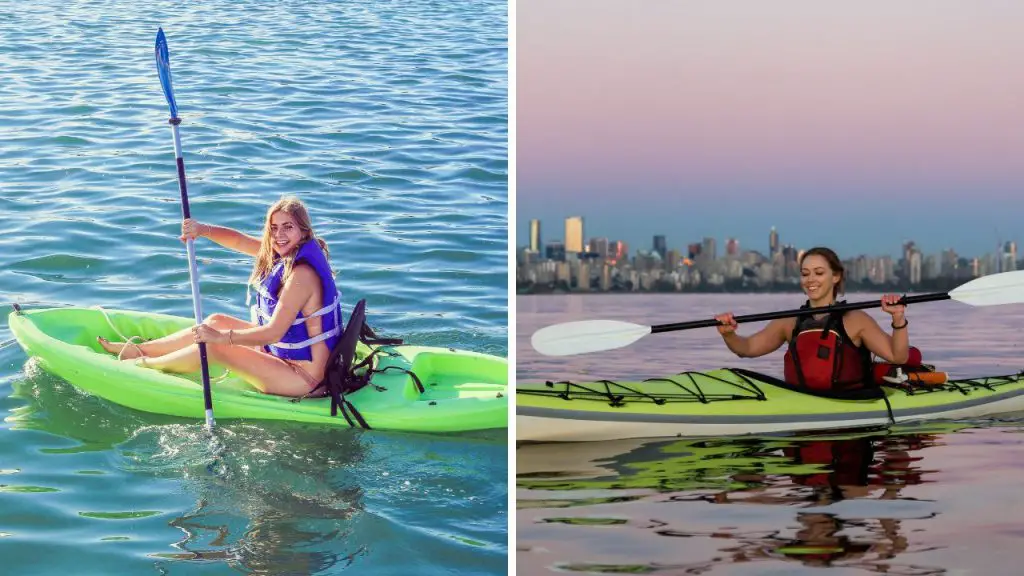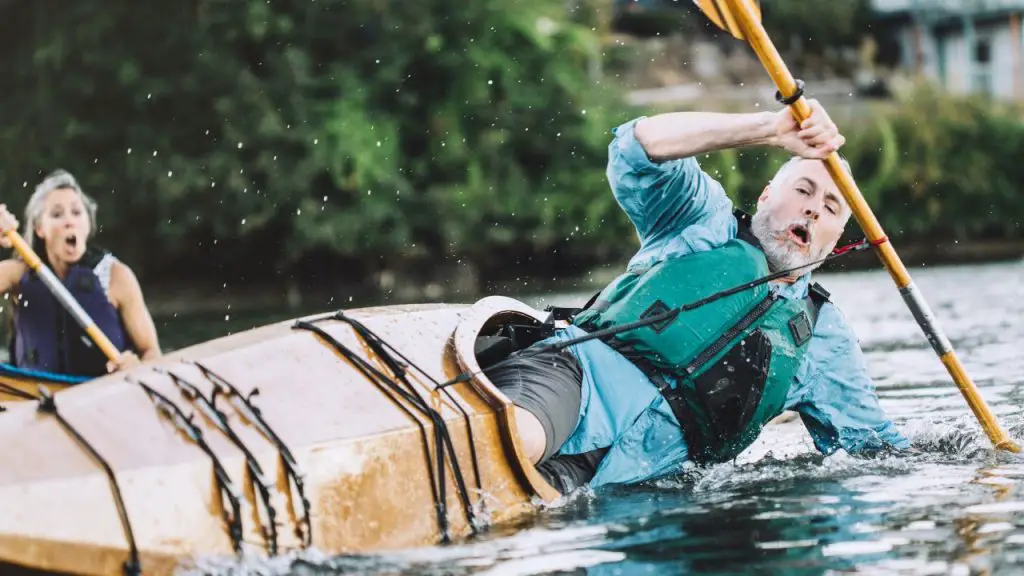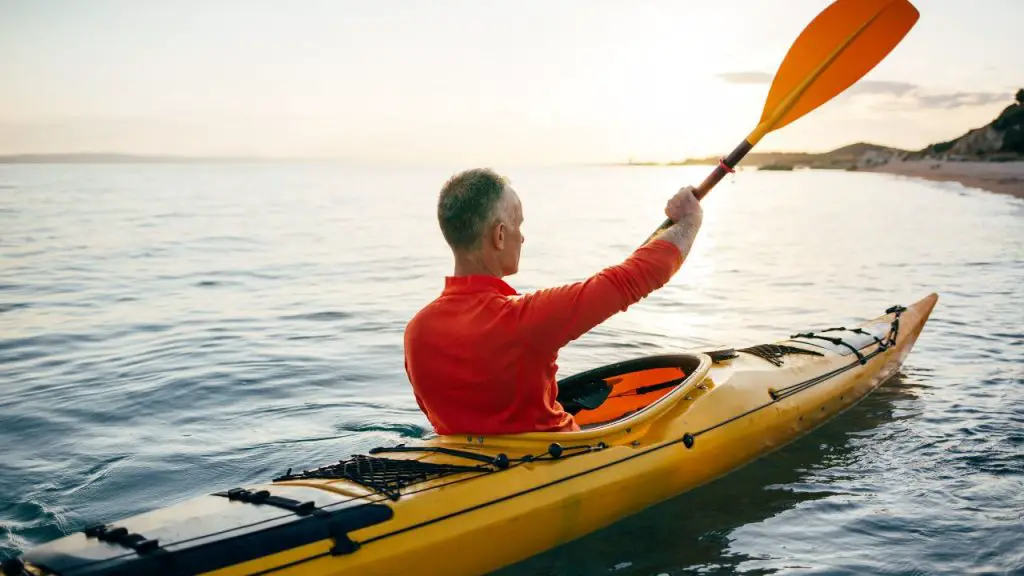Why would a kayak sink? But wait, can a kayak sink? Yes. A kayak can sink when it is overloaded or has suffered severe damage. Sometimes rough waters or bad weather can increase the chances of your kayak sinking.
If you are heading to the waters with your kayak, prepare for any eventuality. Kayak sinking may be a rare occurrence but don’t take any chances. Carry your safety gear and other accessories that help remove water from a kayak and keep you afloat if the kayak sinks.
Read on for detailed causes of your kayak sinking and how to prevent it.
Table of Contents
Do Kayaks Sink?
Yes. Kayaks can sink, but that is not often. It will not generally happen whenever you go out with your kayak, but because of other factors.
Whether your kayak sinks or not depends on the type, loading, and if it has extra features such as bulkheads. Let’s explore a few factors in detail.

What Type of Kayaks Sink Easily?
Kayaks are grouped into two categories: sit-in and sit-on-top. Any kayak type does not sink without a cause. But if you are looking for a nearly unsinkable kayak, opt for a sit-on-top kayak.
Sit-on-top kayaks are described as unsinkable, but they can still sink. These boats have a one-piece molded hull design that makes them almost unsinkable. They also have scupper holes that drain any water that gets in the kayak.
On the other hand, a sit-in kayak is a bit easier to sink because it lacks scupper holes. If you don’t have a bilge pump or other means of getting water out of these boats, they can eventually sink. However, they have a low center of gravity that makes them more stable.
Will a Kayak Sink If It Flips Over?
Yes. A kayak can sink if it flips over and large quantities of water get inside. This is a problem for sit-in kayaks because they are much lower to the water surface and have an open hull. Water can get inside when they flip, which is one of the most common causes of kayak capsizing.
You are safer if you have a sit-on-top kayak. It is more immune to sinking when it flips since it does not have an open hull. Instead, this boat is made of one piece that is mostly closed.
Additionally, sit-on-top kayaks have scupper holes that drain water in case any water gets into the boat. But generally, the two kayak types are not easy to sink and will not sink under normal conditions.

Why Would a Kayak Sink?
Although unlikely, a kayak can still sink. But why would your kayak sink? Are there factors that increase the risk when paddling or enjoying your kayaking adventure? The answer is a resounding yes, and that is because of the following:
Taking a Huge Amount of Damage
Can your kayak still sink even if not overloaded? Unfortunately, yes. Anything can go wrong during your kayaking adventure, which may be disastrous.
Your kayak can sink if it flips or tips over and enough water gets into it. There have been cases of this happening, but they are few. Kayaks cannot just flip without probable cause.
Another possible cause of kayak sinking is severe inclement weather or choppy water. Kayaking in these conditions is risky, even for experienced paddlers. That’s why we advise you to never kayak in harsh weather conditions.
Inexperience can also sink your kayak. You will experience this often if you are a beginner. Kayaking requires skills, and you should adopt the best posture for balance. The boat can tip over and sink if you are not keen on maintaining balance.
A boat leak is also a problem to worry about if you have a sit-in kayak. These boat types do not have scupper holes to drain water that gets into the boat through the cracks on the hull.
Load On Your Kayak Is Too Heavy
Every kayak, whether sit-in or sit-on-top, has a load-carrying capacity. Every manufacturer gives this specification with every model produced.
A golden rule is never to exceed 70% of the kayak’s load limit. Doing otherwise will make it less maneuverable and unstable.
The boat and its content will displace the amount of water equal to its weight. That means an overloaded boat will sit dangerously close to the water’s surface. Any small water current can get into the kayak, causing it to sink since it already has excess weight.
Stay safe by not loading your kayak to more than 70% of its weight-carrying limit. It will make your boat more stable and maneuverable.
What to Do If A Kayak Is Filled With Water?
Water can get into your kayak for different reasons. There can be a hole or crack in the hull, or your boat can scoop water when it tips over. Also, rain can make you be in a pool of water.
Regardless, your action will save you or lead to a disaster. Consider the following to deal with water in your kayak:
Don’t Panic
Many kayakers often panic when water gets into their boat. It can also be the same reaction in your case, especially if you are dealing with it for the first time. But try as much as possible to remain calm for better decision-making.
Panic can lead to hurried decisions and exhaustion that may only lead to disaster. Instead, treat the incident as a common problem and remain composed.
Plug Up the Opening
It depends on how you found yourself in this situation. If it is rain, choppy water, or tipping, this approach won’t apply. Consider it if you have openings on the hull.
Identify the water entry points and plug them up. That should give you more time to paddle to the shore to assess the situation.
Remove The Water
If you have a sit-in kayak, your best bet is removing water if you cannot safely paddle with it to the show. That is where your bilge pump comes in. This hand-operated equipment can effectively remove any water from your boat.
Of course, water will not be a problem if you have a sit-on-top kayak since it drains itself through the scupper holes.
Bring Your Kayak Back to Shore
Weigh all the options above and decide on the best to undertake fast. Removing water from your kayak may take time, and what if you don’t have the bilge pump?
Assess the situation and move to the shore if it is safe. If none of the options is viable, you can abandon your kayak and swim to safety.
Pelican Boats – Paddlers Bilge Floating Hand Pump
What Can You Do To Prevent Your Kayak from Sinking
You can prevent your kayak from sinking by avoiding possible causes such as overloading and kayaking in inclement weather. It is better to take precautions than to be sorry!
Consider using the following tips to prevent your kayak from sinking:
- Wear a life vest in case your kayak sinks
- Avoid exceeding the kayak’s weight-carrying limits – consider your weight and the gear you bring onboard.
- Paddle at your skill level – don’t go on rough waters if you are not experienced enough to maneuver in such conditions.
- Paddle on a good day when the weather is calm and you least expect rain.
- Ensure your kayak has bulkheads to avoid water flooding the entire boat in case of a crack or a hole in the hull.
- Don’t plug all the scupper holes if you have a sit-on-top kayak. Leave some of them unplugged.
- Consider adding extra buoyancy using floatation bladders in the rear and front of your sit-in kayak.
- Ensure your drain plugs are in and secure to avoid water getting into your kayak.
- Act when the kayak is noticeably unstable – don’t venture into deeper waters with such a boat.

FAQs
How do I keep my kayak from sinking?
Your kayak will not ordinarily sink, but anything can compromise its stability. But your boat should be unsinkable if you avoid overloading, kayaking in the rain, plugging scupper holes, and adding extra buoyancy.
Will a sit-on kayak sink?
Yes. Sit-on-top kayaks are generally unsinkable due to their design, but they can still sink. If you don’t want that to happen, leave some scupper holes unplugged and avoid overloading the boat. Also, don’t adventure in dangerous waters.
Do kayaks tip over easily?
No. Kayaks are generally safe and won’t tip over for no apparent reason. The most common causes include imbalance and water conditions. You can control the balance by maintaining the best body posture but it is impossible to do anything about water currents.
Will a kayak float in water?
Yes, but it depends on many factors. Modern kayaks are designed to remain afloat even when filled with water. Float bags and bladders can also help keep kayaks from sinking. But your kayak can still sink under excess loading.
How does a kayak stay afloat?
Kayaks stay afloat by design. Modern boats do not sink even when filled with water. Additionally, you can enhance your boat’s buoyancy by adding floatation bladders and float bags.
Parting Thought
Your kayak would sink if overloaded with fishing gear and other accessories. The boat will not hold on if you exceed its load limit, and to be safe, don’t exceed 70% of its designed carrying capacity.
Also, your kayak can sink if it tips over and enough water gets in. Other possible causes include inclement weather, choppy waters, boat leak, and inexperience. Get some paddling skills before heading to the water all by yourself.
We appreciate your time at Windpaddle reading this article to the end. We believe your doubts are cleared, and you won’t mind sharing this post with fellow paddlers.

